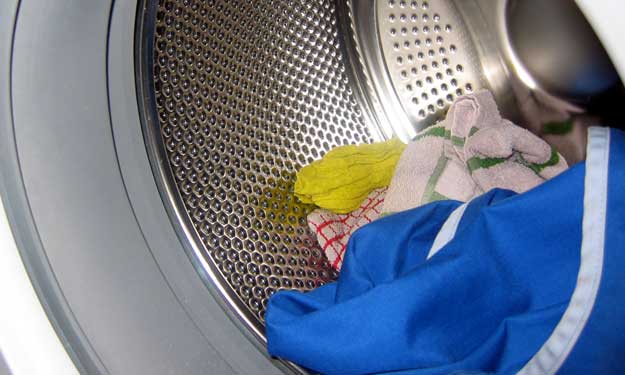Laundry Cleaning Tips

Doing Laundry Does Not Have to Be Difficult with These Basic Tips.
The Basics of Doing Laundry
If you are new to doing your own laundry, let me tell you it does not have to be a daunting task.
Most of the clothes you buy today have symbols on the care label that let you know at a glance if the item should be washed on a cold or hot water cycle, how to dry, if bleach should be avoided, if it can be ironed, if it should lay it flat to dry, etc.
Take a look at these laundry symbols.
Sorting Laundry
Sorting is one of the most important parts of doing a good job when washing laundry. Having several laundry hampers can help make this job easier but not necessary, especially if you are limited on space. If you have just one laundry basket, you can sort your piles the day you wash clothes.
Here are some ideas for sorting and separating laundry but this does not mean you will be washing all these different laundry types every time. Laundry is separated by weight, color, fabric type and how dirty items may be. So for instance:
- Wash darks together.
- Wash lights together.
- Wash delicates together.
- Wash whites separately.
- Wash dirty clothes of the same type separately.
You can wash towels with sheets and washable delicates together. Dry clean items can be set aside and taken to the dry cleaner.
Washing Dark Clothing and Heavy Fabrics
So you may wash a load of jeans together. Jeans are heavy material so if you don’t have a full load of jeans to wash but you have a coat or a throw rug that needs to be washed, you could put these in with the jeans. Dark colors may bleed especially when new so wash these together so they don’t discolor light items.
Bath towels and kitchen towels are also considered a heavy fabric, these can be washed together and if you don’t have a full load, you can add in sheets.
Hand Washables and Delicate Fabrics
This may include items such as your work clothes, undergarments, sleepwear, etc. Sort these by color and wash according to the labels instruction. These types of fabrics will typically require a delicate laundry detergent and a delicate or hand wash cycle.
Washing Whites and Light Fabrics
Once you have separated these from other clothing items do an additional sort by fabric type then sort by water temperature. For example, sort your towels and sheets from the clothing before washing and what can be washed in hot water versus cold water. You can check the manufacturers care tag to see what the recommended temperature is.
Pre-treating Stained Items
If any of the items in your sorted laundry requires a stain treatment, use the best method for the type of fabric and pre-treat prior to washing.
Washing the Laundry
Buy laundry detergents that will best suit your washing needs. This could be scented, unscented, allergy free, delicate detergent, or water temperature specific detergents.
- Prepare the stained items for the load of laundry you’re working on.
- Only use detergent with bleach on white items unless it’s color safe bleach and it specifically states it is safe for colored clothes.
- Use the right amount of detergent according to the package instructions. Too much will leave you with sudsy clothes and too little will leave you with clothes that may not be as clean as you’d like.
- If you use fabric softener that goes in the washer, put it in the correct place or put it in the washer during the correct cycle.
- If your washer doesn’t have a hand wash or delicate cycle option, start hand washing and hang or lay flat on a clean towel to dry.
- Never leave your wet clothing in the washing machine for any length of time. This will lead to musty smells or mildewed clothing and more steps will be necessary.
Drying the Laundry
All right, now that you have washed your clothes, it’s time to dry them. Remember to check labels before drying and do not overstuff the clothes you put in the dryer as this will cause wrinkling. Some fabrics cannot be dried so they will be hung or to lay flat on a towel to air dry.
- When using the dryer, again check the tag on the item of clothing and see how hot a temperature it can withstand.
- If you haven’t used a fabric softener in the washer you may want to use a fabric softener dryer sheet in the dryer to avoid static cling.
- Most dryers have a buzzer letting you know the laundry is dry. So when it’s dry, take the laundry out of the dryer and hang or fold it. Folding clothes as soon as they are dry will prevent a lot of wrinkles.
Ironing
No matter how fast you get to the dryer, there are going to be some items that will need ironing. The easiest way to do this is to iron the garment right out of the dryer, while you’re in laundry mode or maybe you iron while you’re watching a TV show.

